It consists of all the operations pertaining to Lists.
Create List:
This block is used to create a series of list items within a list. It is very similar to the declaration of arrays.
Input | Output | Block Layout | Generated Code |
Value of any type | Returns the list of all the input values | 
| [null, null, null]
|
Length of the List:
This block is used to identify the length of a particular list.
Input | Output | Block Layout | Generated Code |
Variable or list value | Returns the length of the list items. | 
| [].length
|
List Find Value:
It is used to find a particular list item from a list of values. The first or last occurrence of the item within a list is identified in this block.
Input | Output | Block Layout | Generated Code |
Variable or list value for input-1 Choose the type of search The variable or value to be searched for input-2. | Returns the index of the input-2 occurrence in input-1 based on choice. | 
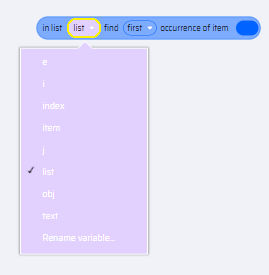
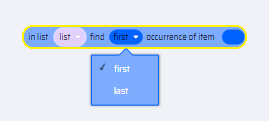
| list.indexOf('') + 1
list.lastIndexOf('') + 1
|
List Get Value:
This block is used to fetch a particular value of a list item within the list. This is done using the GET function. Additionally, there is also another option to 'Get and Remove' the list item once fetched.
The list item can be fetched from the first item, or from the last item, or randomly.
Input | Output | Block Layout | Generated Code |
Variable or list value for input-1 Choose the get or remove type, Choose the get index type, Variable or number for the index input-2. | Get or remove the value of input-2 in the given list input-1 based on choice. |


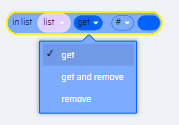
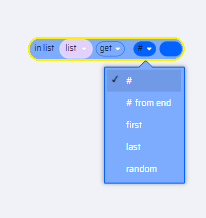
| list[0]
list.splice(0, 1)[0]
list.splice(0, 1)
|
List Set or Insert Value:
Any value can be inserted within a list item of a particular list using this block. Values can be set to the variables of the list item for a Set.
Input | Output | Block Layout | Generated Code |
Variable or list value for input-1 Choose the set type, Choose the set index type, Variable or number for the index input-2, Variable or value to store as input-3. | Store the value to the given input-3 to the list input-1 based on choice and input-2. | 
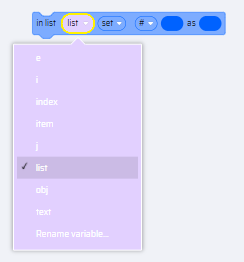

Note When the index type is set to 'last', the insert at type appends a new row or updates an existing row based on primary key of the table variable(in list). 
| list[0] = null
list.splice(0, 0, null)
|
SubList:
This block is used to fetch a sublist from within a list. It is used in a similar pattern to Array Slicing. It specifies a range of values that need to be returned from within the List.
Input | Output | Block Layout | Generated Code |
Variable or list value for input-1 Choose the set index type, Variable or number for the index input-2, Choose the set index type, Variable or number for the index input-3. | Returns the sub list from input-1 based on the choice, from input-2 to input-3. | 
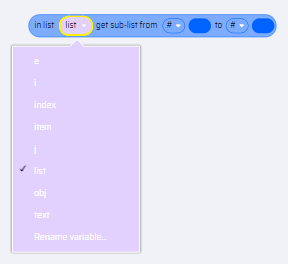


| list.slice(0, 1)
|
List to Text:
This block is used to convert a list items into a series of texts separated by a delimiter. It splits the list items based on predefined conditions and displays the parameters as output text.
Input | Output | Block Layout | Generated Code |
Choose the type list print (list from the text - will convert Text to list base on the delimiter, text from the list - convert list to text based on delimiter), Variable or list or text value for input-1, Variable or text delimiter for input-2. | Returns list or text based on choice using given list or text input-1 and delimiter input-2. | 

| ''.split(',')
[].join(',')
|
Empty List Check:
This block is used to check if a particular list is empty. It verifies the length of the list and returns a boolean output.
Input | Output | Block Layout | Generated Code |
Variable or list value for the input | Returns boolean (true or false) based on the input list length | 
| ![].length
|



















